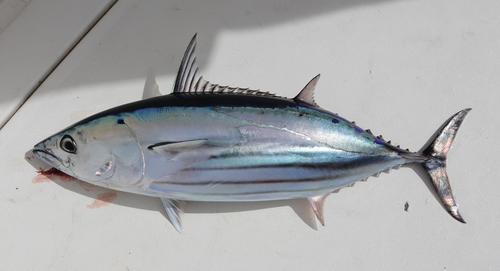
Skipjack Tuna
The Atlantic bluefin tuna (Thunnus thynnus) is a majestic and powerful fish, renowned for its size, speed, and commercial value. This highly migratory species plays a critical role in the marine ecosystem, and is highly prized for its culinary value. It faces significant conservation challenges.
8 12 years
Lifespan
100 - 110 cm
Length
Least Concern
Conservation Status
65 km/h
Swimming speed
Carnivorous, Planktivorous
Diet
Highly Migratory, Pelagic Migration
Migration
Appearance Overview
The Atlantic bluefin tuna is renowned for its metallic blue top and shimmering silver-white bottom, built for speed and endurance.
Color
Dark metallic blue on top with a silvery-white underside
Body
Torpedo-shaped, streamlined for efficient swimming
Fins
Two dorsal fins, the first depressible; small finlets behind second dorsal and anal fins
Length
Typically up to 10 feet (3 meters), can reach up to 13 feet (4 meters)
Weight
Commonly up to 550 lbs (250 kg), maximum recorded weight around 1,500 lbs (680 kg)
Diet
Carnivorous, feeding on a variety of fish, squid, crustaceans, and eels. Also known to consume some plankton and algae.
Feeding Behavior
Aggressive, opportunistic predators that use their speed and agility to hunt. They often hunt cooperatively, herding and trapping prey.
Social Behavior
Highly migratory, forming large schools, especially during spawning. Schools are often segregated by size.
Commercial Relevance
Extremely high value, especially in sushi and sashimi markets, where its fatty flesh is considered a delicacy. This demand drives high prices.
Conservation measures
Subject to international fishing quotas and regulations, managed by organizations like ICCAT. Conservation efforts include stock assessments, fishing gear restrictions, and minimum size limits.
Status
Endangered (IUCN)
Threats
Overfishing (primarily driven by demand for sushi), bycatch in fishing gear targeting other species, habitat degradation, and climate change impacting prey distribution.
Habitat Distribution
Depth Range
Surface waters to depths of over 3,000 feet (900 meters); they often dive deep to feed.
Geographic Range
Western and Eastern Atlantic Ocean, including the Mediterranean Sea. Also found in the Gulf of Mexico.
Preferred Environment
Pelagic, open ocean environments; prefers temperate and subtropical waters.
Reproduction and Life Cycle
Breeding Habits
Spawns in warm waters, with two main spawning grounds: the Mediterranean Sea and the Gulf of Mexico. Spawning typically occurs in spring and summer.
Development Stages
Eggs hatch into larvae within a few days. Larvae are planktonic and grow rapidly. Juveniles school together and gradually develop into adults.
Fecundity
Females are highly fecund, capable of releasing up to 30 million eggs per spawning season.
Maturity Age
Reaches sexual maturity at around 4-8 years in the Mediterranean and 8-12 years in the western Atlantic.
Faqs about Skipjack Tuna
Where can Atlantic bluefin tuna be found?
Atlantic bluefin tuna are found in the Atlantic Ocean, from the Mediterranean Sea to the Gulf of Mexico, and from Norway to Brazil.
How long do Atlantic bluefin tuna live?
They can live up to 40 years, although many do not reach this age due to fishing pressure.
Are Atlantic bluefin tuna warm-blooded?
Atlantic bluefin tuna are warm-blooded, unlike most fish, which allows them to maintain a higher body temperature than the surrounding water.
How fast can Atlantic bluefin tuna swim?
They can swim at speeds up to 43 mph (70 km/h) in short bursts.
Do Atlantic bluefin tuna migrate?
Yes, they are highly migratory, often crossing the entire Atlantic Ocean to feed and spawn.
Why are they endangered?
The population has been severely depleted due to decades of overfishing, leading to strict fishing quotas and conservation measures.
Copyright @ Nature Style Limited. All Rights Reserved.
 English
English